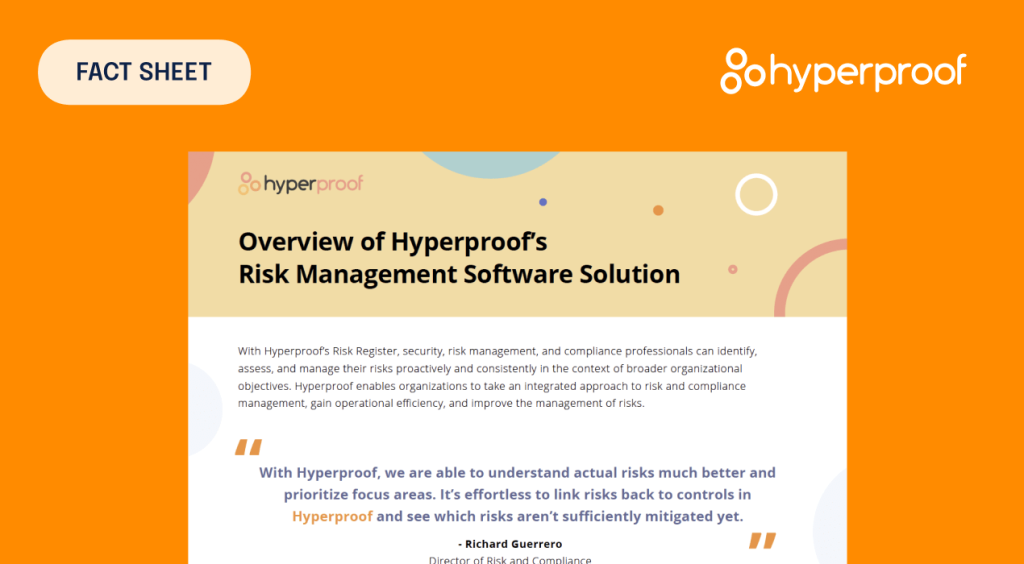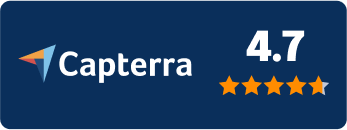
When it comes to adding a Governance, Risk, and Compliance (GRC) platform to your existing tech stack, there are a lot of things you should take into consideration. From budget constraints to how a tool integrates with your existing systems, this decision will impact nearly all facets of your security and compliance program. That’s why we’ve identified the top features you need in a GRC platform so you can be confident that you’re making the right choice.
What Is GRC Software?
Governance, Risk, and Compliance (GRC) is defined by the OCEG as “the critical capabilities that must work together to achieve Principled Performance — the capabilities that integrate the governance, management and assurance of performance, risk and compliance activities.”
If GRC forms the basis by which companies meet performance principles, then GRC software is the platform that helps companies to achieve that performance. A GRC software is designed to help organizations collect, organize, analyze, and report the data necessary to comply with a wide range of requirements and standards. Having a thorough GRC program and software is critical to not only meeting compliance standards, but doing so in an efficient and scalable way.
4 Questions to Ask When Choosing GRC Software
Before you dive into what makes or breaks a GRC platform, there are a few things to consider and questions to ask your internal team and stakeholders. It’s critical to get everyone on the same page when it comes to understanding needs, setting goals, and establishing expectations before trying to select a GRC software. How can you make a choice if you’re not yet aligned on what you need? Of course, every organization is different, but there are some questions that every company needs answered before deciding on a GRC software.
Question #1: What Problems Do You Need to Solve?

First, it’s important to be clear about the specific problems you’re looking to solve. What’s the real challenge for your organization? What problem, if it goes unsolved, threatens to introduce the greatest risk, costs and operational headaches for your team and the organization?
First, it’s important to be clear about the specific problems you’re looking to solve. What’s the real challenge for your organization? What problem, if it goes unsolved, threatens to introduce the greatest risk, costs and operational headaches for your team and the organization?
Some examples of problems organizations would like to solve include:
- Compliance is so time-consuming that it’s becoming an unsustainable cost
- Keeping controls up-to-date; a faster way to collect the evidence needed for audits
- Not knowing where gaps exist in the control environment and want stronger monitoring capabilities
- Reporting is too hard and takes too long to answer simple questions about cybersecurity from the board
- Responding to security questionnaires from customers takes too much time
- Teams are adhering to specific cybersecurity frameworks on paper, but don’t know how secure they truly are.
Different GRC solutions solve different types of problems; some claim to solve for a host of issues but are actually only great at solving for one or two.
If you want to pick the right solution and get immediate value from it, it’s vital you get clear on the problems that matter most to you and your key stakeholders.
Question #2: What Do Your Stakeholders Need?

This question is centered around understanding your stakeholders and their needs.
Who in your organization will be the power-user of the tool? Who will occasionally use the GRC tool? And who will consume reports and information generated by the tool to make business decisions?
We’ve all seen shelf-ware before. You don’t want your GRC solution to become one.
As such, you want to get clear on who needs what functionality and how often they will be using the tool. Map out what are your must-haves versus nice-to-haves for all user types.
For instance, the compliance program director’s core needs for a GRC tool might be around organization, efficiency and accountability.
Thus, in a GRC tool, they have to be able to manage various infosec frameworks, quickly migrate the existing compliance programs into the tool, collect evidence for audits and ongoing control evaluations, and assign control ownership to other stakeholders, create tasks for team members and keep team members accountable.
On the other hand, the CISO will need reports that help them understand how well-protected the organization is from risks that matter.
Meanwhile, there may be others in your org who occasionally provide information for audits. These people don’t want to learn another tool. In this case, you may say that one must-have criterion in a GRC tool is integration with your existing productivity tools and file storage systems.
Question #3: What Level of Resources Do You Have For Implementation?
Do you have a full-time person who can implement your GRC software and manage it on an ongoing basis? Do you have an outsourced team or a virtual compliance officer who can manage your compliance program and the tool for you? Or is compliance just 25% or 30% of one person’s job?
Some GRC tools are quite easy to implement, and others are heavy-duty and require much longer ramp-up time.
Make sure to pick something that works for the team you have right now, not something that works for the 10,000-person company across town.
Question #4: What’s Your Budget?

GRC solutions’ price range runs the gamut from four figures per year in annual recurring cost all the way to seven figures per year in annual recurring cost. Further, you’ll want to factor in the personnel costs if you’re going to hire someone to implement and manage the tool on your behalf.
Budgeting looks different for every organization, but some best practices to consider when creating your budget and submitting it for board approval include:
- Determine the cost of your current GRC program: It’s likely your current GRC program is costing you more in time, resources, and dollars than a GRC software will.
- Determine the cost of different levels of GRC software: Examine the differences between an all-in software budget, a bare-bones budget, and multiple levels in between.
- Prioritize your needs: By asking the questions above, you should have your GRC software needs prioritized already. Cross-check the needs priorities with your different levels of software budgets to see where needs and features can align.
- Explore financing options: Many GRC software options will provide flexible timetables for payment, whether monthly, biannually, or annually. Determine the best short-term and long-term options for your current and future financial situations.
Remember, a GRC tool is only ROI positive if the value it has provided in time-saving, operational improvements and risk reduction is greater than the fully loaded cost of the tool.
Top 5 Most Important GRC Tool Requirements
Making time for discovery within your organization will help smooth out the overall search process so it’s less painful. Once you’ve laid this groundwork, you can focus on the key differentiators for all of the GRC platforms in the compliance landscape today.
Let’s talk about the five most important features your GRC platform should have.
1. Workflow Automation

One of the best parts of a GRC platform is the automation of your common workflows. From automating evidence collection to real-time reporting on risk and controls, you can do a lot more with the time saved by automation. However, that doesn’t mean you should rely solely on automation.
Putting all of your compliance efforts on autopilot can spell disaster. Managing a GRC platform (and compliance program) should be an active, ongoing process that requires strategic human contribution. After all, that’s what makes GRC what it is: the knowledge and expertise of employees building the overall program. So, automation should fit into your existing workflows and make your life easier, not harder.
But, automation does help prevent manual, human errors. With some GRC platforms, you can automate proof collection by using APIs, which are then set to pull information from your other systems on a schedule you choose. This not only has time savings, but also cost savings — because you can do more with less, faster. With GRC platforms, you can automate many of the tasks that used to take you hours — including automated controls, or continuous controls monitoring (CCM). We define CCM as the application of technology to allow continuous or high-frequency monitoring of controls to validate the effectiveness of controls designed to mitigate a wide range of risks.
With CCM, you no longer need to manually test your controls — they’re continuously monitored for you by the GRC platform. You can instantly receive alerts when risk is detected so you’re not leaving the company vulnerable to threats. Plus, some GRC systems allow you to create tasks within the system when things fail so your team can quickly improve security, all in one place.
“This year, we invested time in setting up our GRC platform in a way that will help us reap the benefits of automation next year and for years to come . . . We plan to further automate our compliance operations with the ultimate goal of automating everything we can automate.”
Mike Caldwell, Senior Program Manager, GRC, Outreach
2. Cutting-Edge Security Combined with Ease-of-Use

It may seem obvious, but since your GRC platform is where vulnerabilities are stored and cataloged, you need a tool secure enough to keep your data safe, all while enabling you to do your work more efficiently. Finding the GRC platform that puts user experience first and stores data securely may sound like a far-off, distant dream, but it’s not.
Some legacy GRC platforms store your data securely, but their interfaces are clunky and difficult to manage. Others have flashy UI and UX with vulnerable databases that anyone could infiltrate. Luckily, new solutions are surfacing in the market that marry ease of use and security so you know your data is protected and your team can easily manage compliance without building Excel formulas or spending hours trying to navigate an unintuitive platform. Secure access to the right data is important, too. Your GRC platform will contain information about your greatest vulnerabilities, so it’s vital that stakeholders only get access to what they need to do their work. Rich collaboration tools within GRC platforms allow you to control who can access what while still enabling team efforts. Creating tasks, managing teams, and remaining secure should be easy and intuitive within the tool, so you can keep your data safe and organized.
“Because all of our controls and the details about how those controls function are stored in our GRC platform, I can easily retrieve information I need to answer customers’ questions. Our organization is able to be responsive to our customers and demonstrate that we are working towards becoming first-in-class from a security standpoint.”
Mohamed Manga, Engineering Manager – Digital Enablement, Unifonic
3. Ensure Your GRC Platform Can Scale

Scaling compliance is a difficult, painful process. Adding additional frameworks, collecting evidence, and maintaining compliance become cumbersome and difficult to manage without a GRC platform. You’re probably also stressed about managing it all on your own, on top of all the other legal and security risks (not to mention growing data breaches). That’s why choosing the right GRC platform means choosing one that helps you do your job.
From assigning tasks to stakeholders, understanding your risk posture, and organizing evidence, the right platform is one that simplifies your day and makes compliance easier. Without a unified platform, you may struggle to truly know that your program is successful when managing it from complex spreadsheets. And, the thought of adding more frameworks probably just adds more stress. That’s why a system that can properly scale will help take the pressure off of you as you adhere to more and more compliance frameworks.
High-quality GRC platforms have the ability to scale alongside their customers. As your business grows, the platform does too, making tasks simpler and easier even when your organization becomes larger.
Another perk is having open lines of communication between customers and product teams. When you have good communication, you get a positive feedback loop, meaning customers’ feedback directly impacts the newest features and product roadmap.
Scalability is vital to GRC platforms. As you grow, you don’t want the product to grow stagnant, but rather enable you to remain compliant and secure at any size.
“As our company continued to expand and grow, we needed a GRC platform that was going to grow with us and not feel limited by the functionalities that we had here in place.”
Jessica Parant, Compliance Specialist, Pythian
4. Dashboards and Reporting

One of the most important aspects of a GRC platform is reporting and dashboarding. Managing compliance in spreadsheets makes reporting a complex, manual task. The data also doesn’t automatically update, meaning you’re left to hope you have the most up-to-date information when presenting to your executive team. Add in the potential for human error, and are you really confident in that report after all?
With reporting in a GRC platform, you can easily see what controls are important to you, and know which control families are “in the red.” Reports can also allow you to see top risks and any significant changes in them, such as percent increases or decreases. You can also view which controls might be important to cyber insurance policy renewals, and how they’re tracking. Reporting in your GRC platform simplifies the manual tasks you have to perform, all while giving you confidence in your numbers and key risk indicators (KRIs). But then, you can also pull all of these reports into dashboards.
With the right GRC platform, you can quickly create a consistent and shareable dashboard that takes no additional time to build. Not only do your stakeholders have a source of truth they can trust, but you also save hours of time and get out of spreadsheet hell, leaving you able to do more meaningful work. Your data becomes more consistent, updates automatically, and you can trust what you share. Plus, stakeholders can understand your risk posture at a glance, and you won’t spend hours parsing Excel data or scrambling to answer compliance questions.
You’ll also be able to easily present information to the board, from the amount of money spent on risk management to trendline changes in risk over time. Dashboards can also display organizational cybersecurity maturity and the top risks your CISO may need to make decisions on.
It’s all of the information you want, when you need it — in a single easy-to-build format. A GRC platform helps you know where your organization stands at a glance.
“With our GRC platform, we can immediately understand our compliance posture because it provides a single source of truth on controls that is more reliable than Google sheets.”
Mike Caldwell, Senior Program Manager, GRC, Outreach
5. The Right Integrations
A GRC platform with access to all of your compliance data, evidence, and controls all in one place will give you a lot more time back to focus on more important tasks.

If your GRC platform can’t talk to the existing tools in your tech stack, you should expect to perform a lot of manual work bouncing between systems. From pulling reports and data to manually uploading them to the platform, your day just got more complicated, not simpler.
A platform with the right integrations – like Jira, AWS, Okta, Cloudflare, and more – will make your life easier. You’ll be able to access all of your compliance data, evidence, and controls all in one place, which will bring you peace of mind and a lot more time back to focus on more important tasks.
Powerful integrations lay the groundwork for a successful GRC platform, as they allow you to connect everything so your team can collaborate in one system. Plus, without integrations, many automations are proven useless. Who would want to use a GRC platform that doesn’t have the right integrations? You’d just be asking for even more manual work, which brings us to the next point.
“When I stepped into my current role, we had separate compliance and risk management programs. All efforts were siloed. I wanted to fully integrate the two siloed programs into a single unified risk and compliance program.”
Richard Guerrero, Director of Risk and Compliance, Clarifire
Find What Matters in GRC Software for Your Organization
Choosing the right GRC platform is hard, but knowing what’s most important for you and your organization is key to choosing the right one. Ultimately, what matters most is that you find a platform with all the features listed above that will enable your team to maintain compliance without the headache of manual processes or inflexible legacy solutions.
Quick tip: Hyperproof is a platform that provides all the integrations, features, and automations that you need to make your GRC program run smoothly. Plus, it’s easy to use and can scale with you as your business grows. Not to mention it will get you out of spreadsheets and into a GRC platform that understands the way you work. If you’re ready to learn more about Hyperproof, check out our case studies or request a demo and meet with one of our compliance operations specialists.
Monthly Newsletter
Get the Latest on Compliance Operations.








